Markets
Cotton Closed a Little Higher on Friday but a Little Lower Last Week
Daily chart trends for cotton turned down. The weekly export sales report showed diminished sales. The US economic data has been positive, but the Chinese economic data has not been really positive and demand has been down. There are still many concerns about demand from China and the rest of Asia due to the slow economic return of China in the world market.

Wheat: Wheat markets were a little lower last week as no new big export sales have been reported for at least the last two weeks. Black Sea offers are still plentiful and Russian prices appear to be about 260.00 per tons FOB. News that Argentina will restructure its economy with a shock devaluation of the peso and structural changes inside the country created ideas that farmers would sell, but it is unlikely they will sell right away and might be better off to wait and see a more calm situation.
China was a big buyer of US Wheat a couple of weeks ago and helped produce a big rally in the market. China has stopped buying for now and the market gave back about half the rally before finding its footing yesterday. Russia is still exporting and offering Wheat into the world market and is reporting that the crop is larger than originally thought. Ukraine and the EU countries are offering as well and are getting new business. Demand has been poor for US Wheat as Russia production looks strong, but exports are starting to increase.
Weekly Chicago Soft Red Winter Wheat Futures
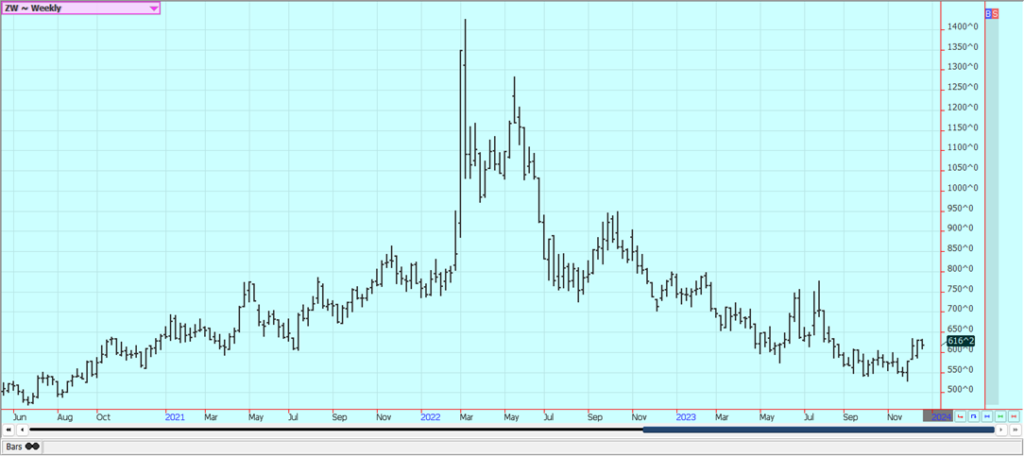
Weekly Chicago Hard Red Winter Wheat Futures
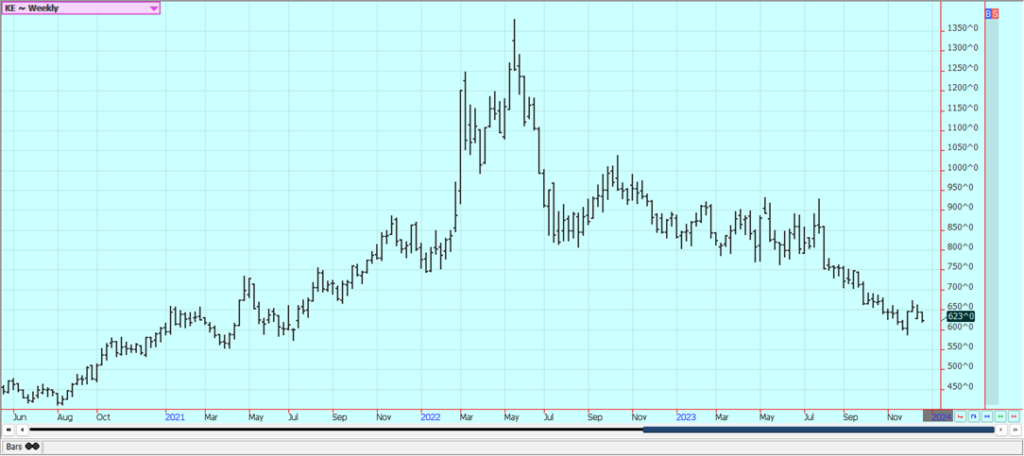
Weekly Minneapolis Hard Red Spring Wheat Futures
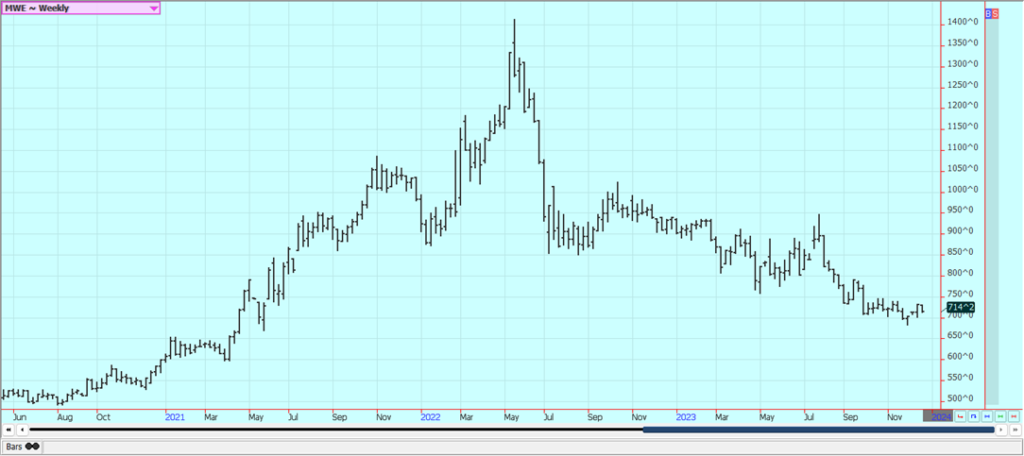
Corn: Corn closed a little lower last week on ideas of big US production. The market anticipates increased selling from producers, but many have sold enough and elevators and processors are reported to be full. Oats were lower. Ideas of weak demand are keeping prices low over all, but the weekly export sales reports have shown good demand for the last several weeks.
The market feels that there is more than enough Corn for any demand and are not buying futures despite the improve demand. It is still hot and dry in central and northern Brazil and in Argentina although some showers have been reported in Argentina and in central and northern Brazil. Southern Brazil is still much too wet.
Weekly Corn Futures
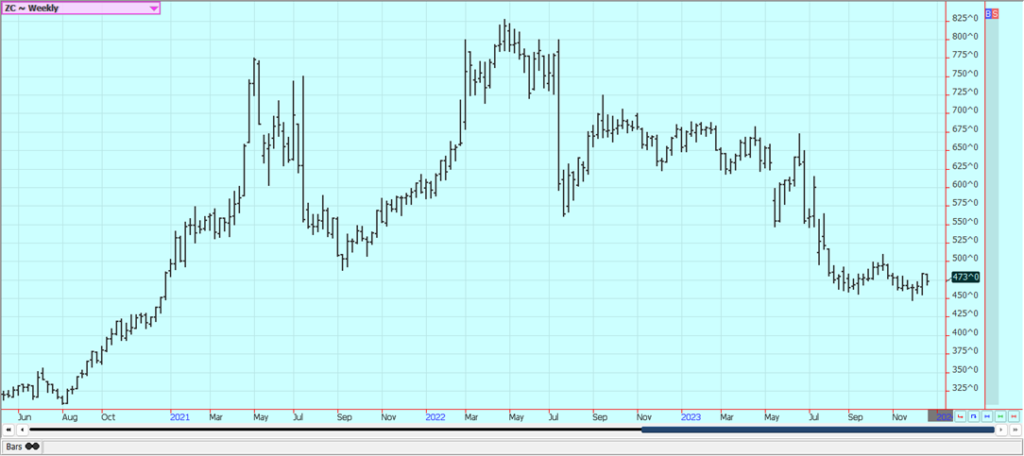
Weekly Oats Futures
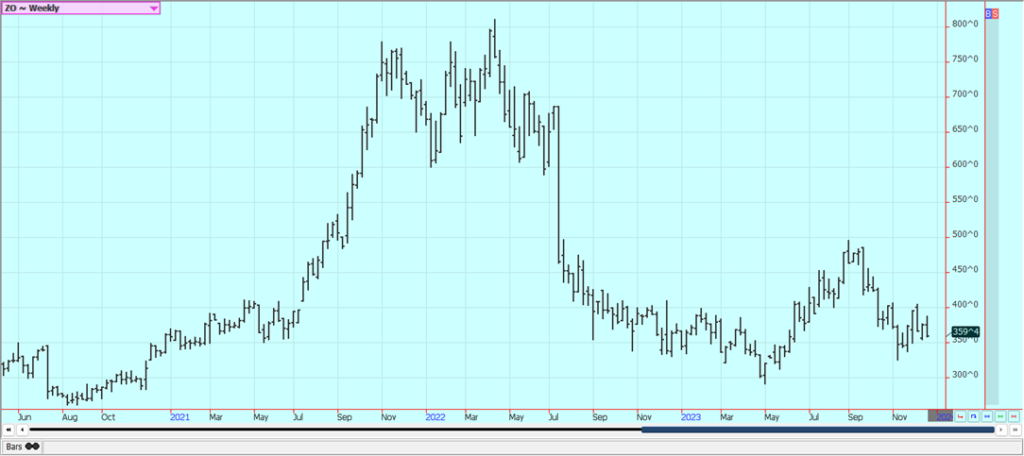
Soybeans and Soybean Meal: Soybeans and the products closed lower last week on long liquidation. Less than expected rains in central and northern Brazil last week and forecasts for reduced rains this week were supportive. Too much rain was reported for southern Brazil again. There are some forecasts for scattered showers and rains this week in central and northern Brazil and still very wet conditions in the south.
The trade remains concerned about the weather forecasts for South America but is holding to ideas of production well over 150 million tons. Our source suggests that production in Brazil could be much less due to the extreme weather seen already. Brazil remains mostly hot and dry in northern areas and too wet in southern areas. Argentina crops are reported o be in good condition with enough moisture.
These weather trends are expected to continue after next week. The market also heard that Argentina has devalued the Peso in a drastic way and plans to cut government spending in a major change for the economy there. Soybeans export taxes could be cut but Corn and Wheat taxes raised. The market anticipates an uptick in selling but might have to wait until the economy becomes more stable.
Weekly Chicago Soybeans Futures
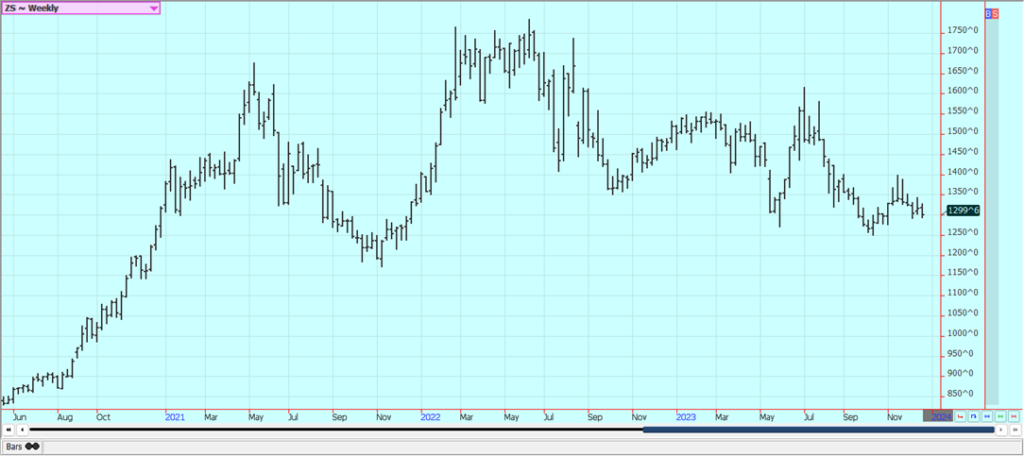
Weekly Chicago Soybean Meal Futures
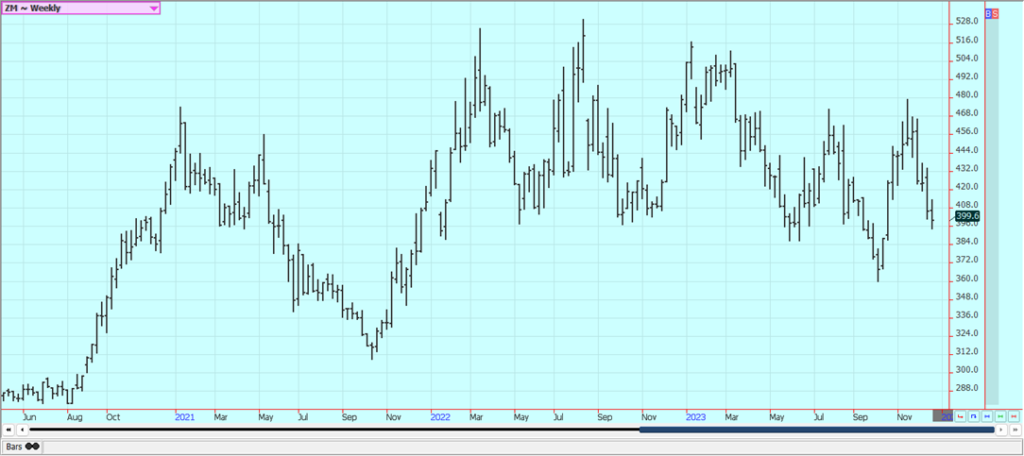
Rice: Rice closed higher last week but trends are sideways on the daily charts again. Farmers appear quiet in the market and basis levels are reported to be steady, but industry and speculators have been busy.
The roll out of January positions has been very active and some selling is noted on rallies in September. Most farmers are hunting and getting ready for the holidays and are not interested in Rice markets. Demand reports have been solid to strong for the last couple of weeks and have featured traditional buyers in Latin America and Asia. The sales were very good last week again.
Weekly Chicago Rice Futures
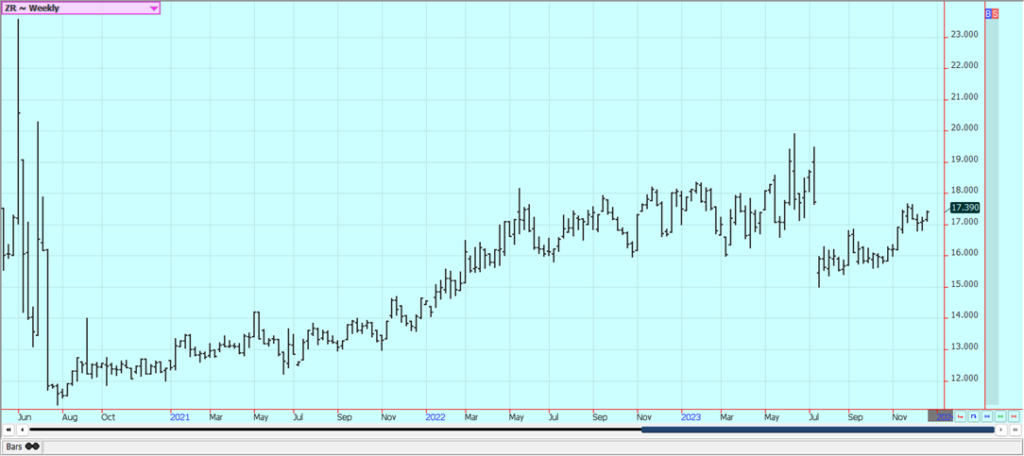
Palm Oil and Vegetable Oils: Palm Oil was higher last week on weekly continuation charts, but lower overall on ideas of weaker demand for Palm Oil as the private sources reported improved demand for Palm Oil and as the weather situation is good for production. There had been concerns about too dry weather caused by El Nino. Production was high in the MPOB reports but is expected to drop seasonally in future reports.
Trends are sideways on the daily charts and are sideways on the weekly charts. Canola closed slightly lower. Current forecasts call for very wet weather in southern Brazil and wetter weather in central and northern areas this week. The Canola crop is harvested and it is in bins, so it will take some price movement to get new farm sales. Trends are mixed on the daily charts in this market.
Weekly Malaysian Palm Oil Futures
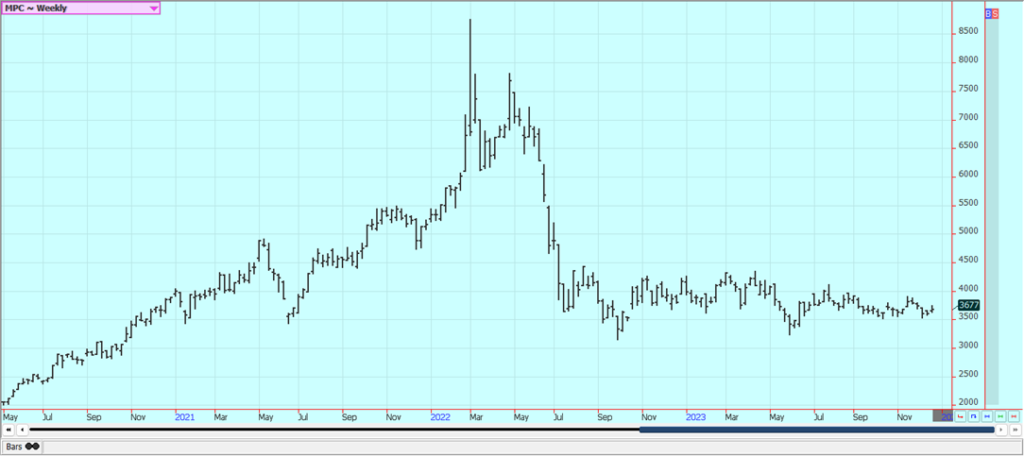
Weekly Chicago Soybean Oil Futures
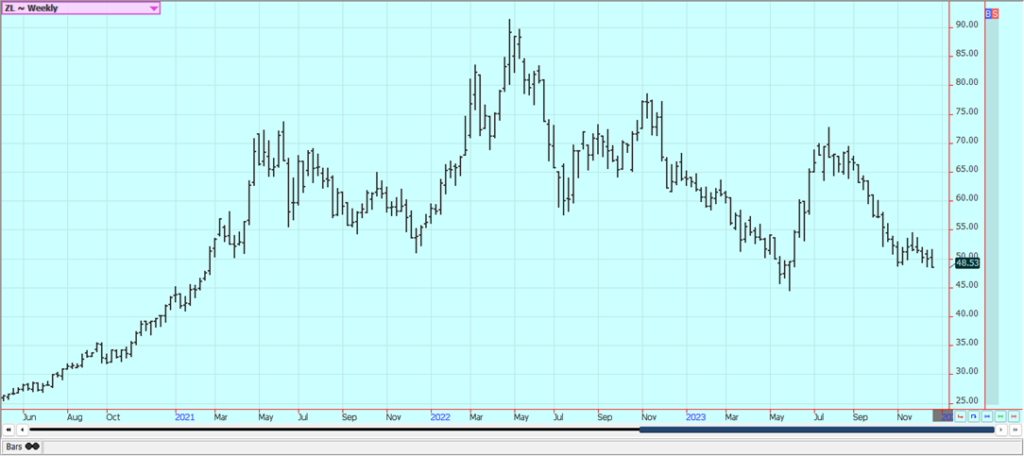
Weekly Canola Futures:
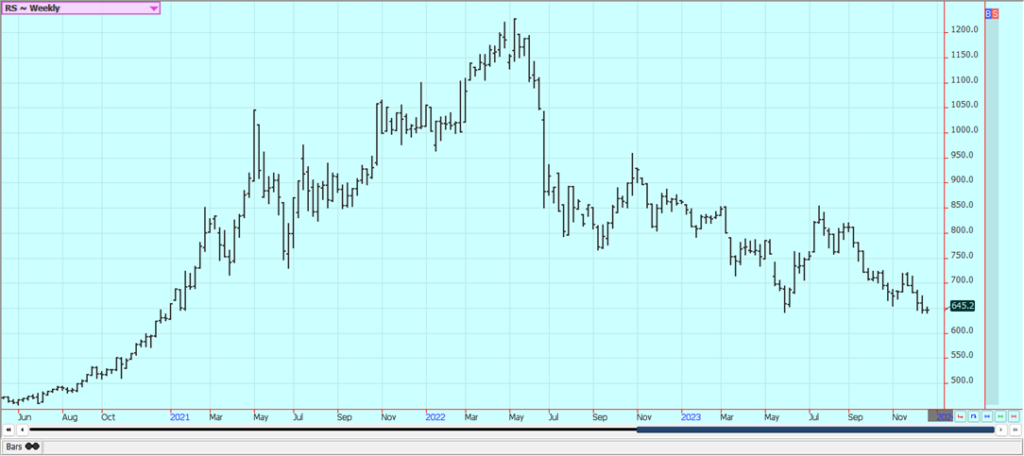
Cotton: Cotton closed a little higher on Friday but a little lower last week in follow through selling. Daily chart trends turned down. The weekly export sales report showed diminished sales. The US economic data has been positive, but the Chinese economic data has not been real positive and demand has been down.
There are still many concerns about demand from China and the rest of Asia due to the slow economic return of China in the world market. There are production concerns about Australian and Indian Cotton as both countries are likely to suffer the effects of El Nino starting this Fall.
Weekly US Cotton Futures
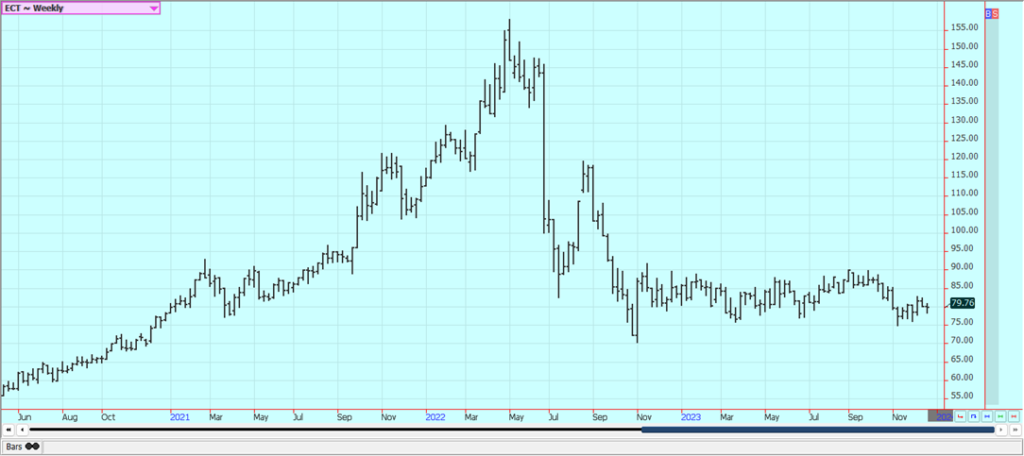
Frozen Concentrated Orange Juice and Citrus: FCOJ closed lower last week and the trends are turning down in this market. Futures gapped lower a few times over the second half of the week. The moves imply that supply is finally getting bigger than demand and implies that consumer demand has dropped significantly in recent weeks. There are no weather concerns to speak of for Florida right now with the hurricane season all but over and no major storms hitting the state recently.
The weather has improved in Brazil with some moderation in temperatures and increased rainfall in the forecast for this week. Brazil got more than expected rains over the weekend. Reports of short supplies in Florida and Brazil are around. Historically low estimates of production in Florida due in part to the hurricanes and in part to the greening disease that have hurt production, but conditions are significantly better now with scattered showers and moderate temperatures.
Weekly FCOJ Futures
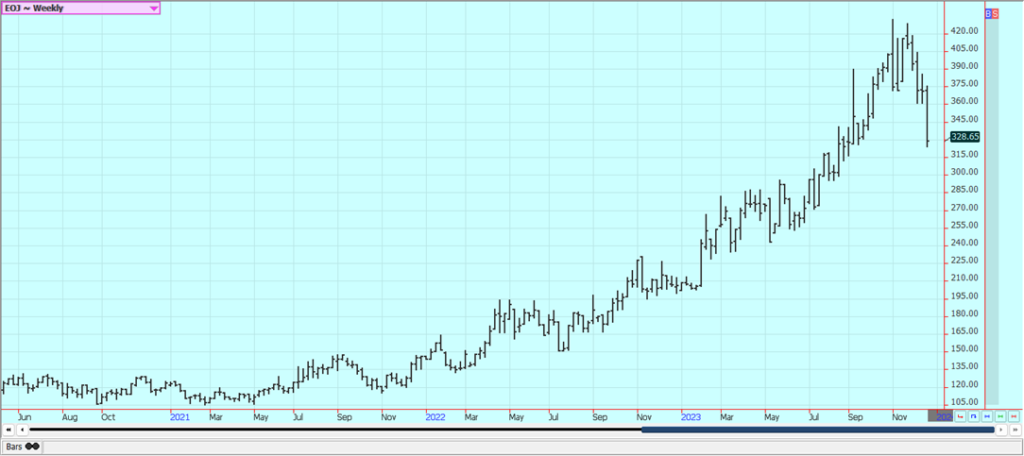
Coffee: New York closed lower last week after making new highs for the move earlier in the week and despite less than expected rainfall for Brazil production areas. London closed lower after a sharp move higher Thursday based on less on offers from Asia and Brazil. The rally in January futures was extreme and is reflecting the lack of spot supplies to the market. London has given back most of the rally on Friday.
Arabica and Robusta areas are affected by drought and forecasts call for reduced rainfall totals this week to keep ideas of stress alive. Espiritu Santo is the most affected state, but all states are being hurt to some degree. Brazil weather remains uneven for the best crop production, but there are reports of increasing Coffee availability from Vietnam although not enough to meet all of the demand yet. The lack of offers from Asia, mostly from Vietnam but also Indonesia have been a main feature of the market, but the offers are starting to improve.
Weekly New York Arabica Coffee Futures
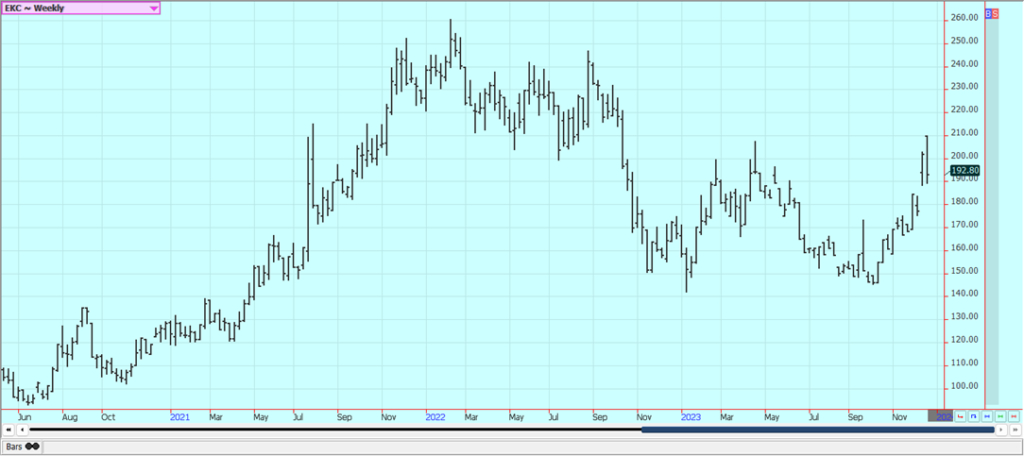
Weekly London Robusta Coffee Futures
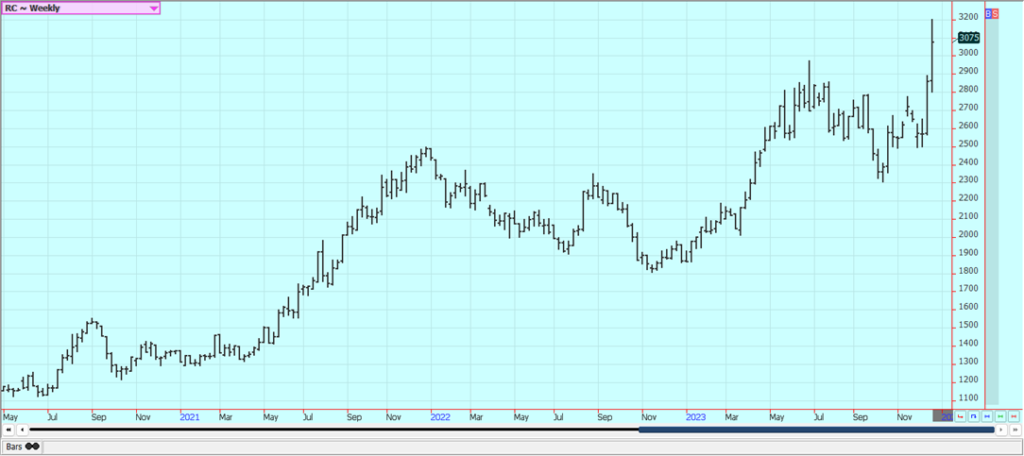
Sugar: New York and London closed lower again last week on reports of greatly increased availability of Ukrainian Sugar in the EU. Less than expected rains fell in Brazil last week and Brazil weather forecasts now call for wet in the south and continued scattered showers in central and northern areas this week. The market continues to see stressful conditions in Asian production areas but has noted that India has changed its Ethanol policy to make more Sugar available to the market.
The Brail rains is underway now and have been heavy in the south but has been lacking in the north. There are worries about the Thai and Indian production potential due to El Nino and talk that India could turn into an importer next year. Offers from Brazil are still active but other origins. are still not offering or at least not offering in large amounts except for Ukraine, and demand is still strong. Brazil ports are very congested, so shipment of Sugar has been slower.
Weekly New York World Raw Sugar Futures
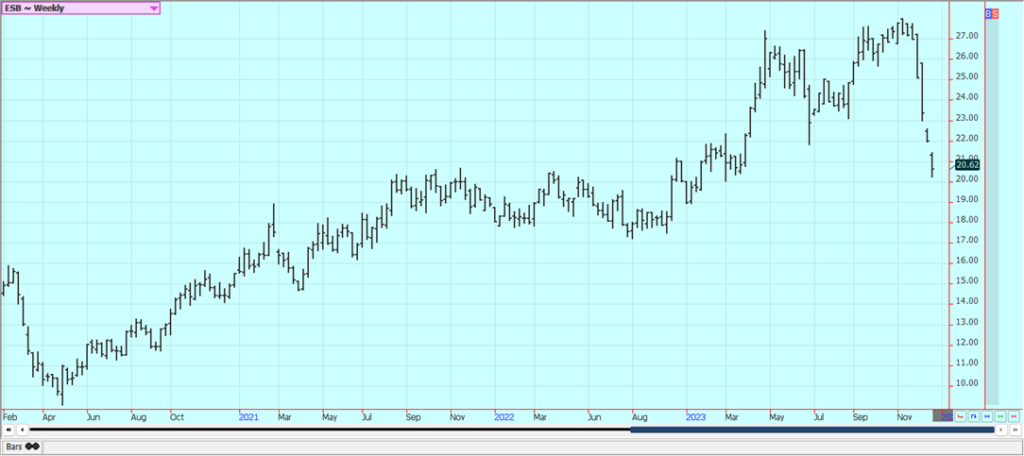
Weekly London White Sugar Futures
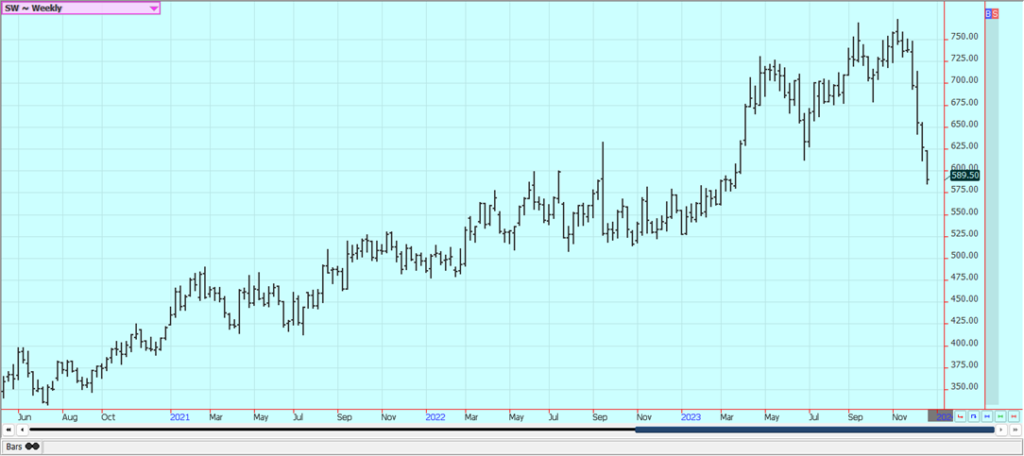
Cocoa: Both markets closed a little lower last week and remain in a trading range. Traders are worried about another short production year and these feelings have been enhanced by El Nino that could threaten West Africa crops with hot and dry weather later this year.
The main crop harvest comes into focus and as farmers in West Africa report that many areas have too much rain that has caused harvest delays and could lead to disease. Scattered to isolated showers are reported in the region now and the harvest is coming. Ideas of tight supplies remain based on more reports of reduced arrivals in Ivory Coast and Ghana continue,
Weekly New York Cocoa Futures
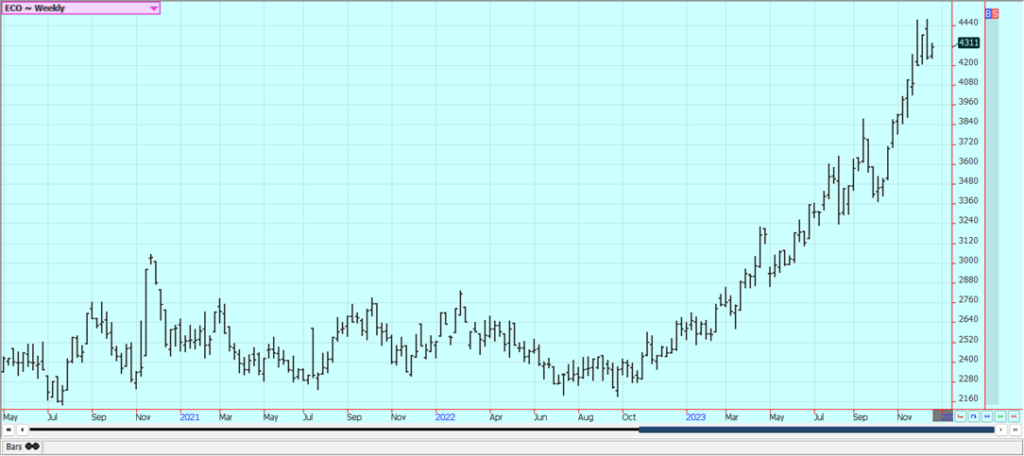
Weekly London Cocoa Futures
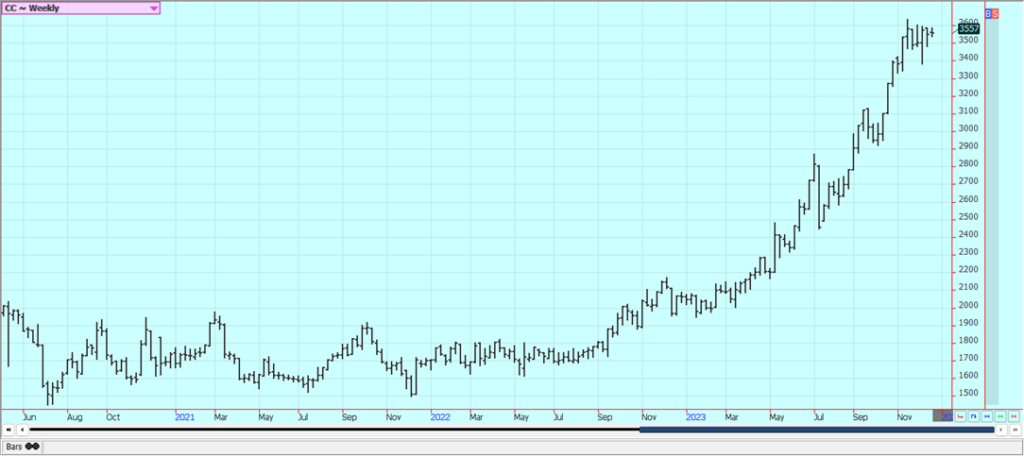
__
(Featured image by Karl Wiggers via Unsplash)
DISCLAIMER: This article was written by a third party contributor and does not reflect the opinion of Born2Invest, its management, staff or its associates. Please review our disclaimer for more information.
This article may include forward-looking statements. These forward-looking statements generally are identified by the words “believe,” “project,” “estimate,” “become,” “plan,” “will,” and similar expressions. These forward-looking statements involve known and unknown risks as well as uncertainties, including those discussed in the following cautionary statements and elsewhere in this article and on this site. Although the Company may believe that its expectations are based on reasonable assumptions, the actual results that the Company may achieve may differ materially from any forward-looking statements, which reflect the opinions of the management of the Company only as of the date hereof. Additionally, please make sure to read these important disclosures.
Futures and options trading involves substantial risk of loss and may not be suitable for everyone. The valuation of futures and options may fluctuate and as a result, clients may lose more than their original investment. In no event should the content of this website be construed as an express or implied promise, guarantee, or implication by or from The PRICE Futures Group, Inc. that you will profit or that losses can or will be limited whatsoever. Past performance is not indicative of future results. Information provided on this report is intended solely for informative purpose and is obtained from sources believed to be reliable. No guarantee of any kind is implied or possible where projections of future conditions are attempted. The leverage created by trading on margin can work against you as well as for you, and losses can exceed your entire investment. Before opening an account and trading, you should seek advice from your advisors as appropriate to ensure that you understand the risks and can withstand the losses.

-

 Crypto5 days ago
Crypto5 days agoBitMine Surpasses 4 Million ETH Holdings Amid Market Volatility
-

 Crypto2 weeks ago
Crypto2 weeks agoTether Targets $500 Billion Valuation in Landmark Funding Push
-

 Markets7 days ago
Markets7 days agoDow Jones Strength Faces Risk From a Potential Yen Carry Trade Unwind
-

 Business2 weeks ago
Business2 weeks agoPrecious Metals’ Bull Market Continues
























